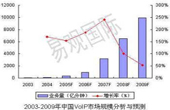The global VoIP service market is expanding rapidly
Since 2006, the global VoIP market has developed rapidly, especially in developed countries, the scale of the VoIP market is expanding rapidly, and its substitution effect on traditional telephones is gradually strengthening. For example, both the British regulatory agency OFCOM and the Irish regulatory agency ComReg expect that all voice services will be transferred to IP technology in the near future.
1. The compound annual growth rate of VoIP users will exceed 50%
According to the prediction of the consulting company iDATE, the number of global VoIP users will exceed 200 million in 2010 and reach 250 million by the end of 2011. According to these predictions, it can be seen that from 2007 to 2010, the average compound annual growth rate of VoIP users will exceed 50%, much higher than the growth rate of traditional telephones including mobile phones. iDATE also estimates that by 2011, the number of VoIP users in the form of broadband telephony will account for more than 16% of the total number of telephone users.
In addition, due to different conditions in each country, the development of VoIP shows distinct regional differences. Japan was one of the early countries to open VoIP services, with an early start and almost an absolute dominant position in the global VoIP market before 2005. After 2005, the VoIP markets in other regions also began to develop rapidly, such as the United States and Europe, which has led to the rapid growth of the shares of Europe and the United States in the global VoIP market.
Skype is the most notable VoIP service provider in the world. The number of quarterly growth users exceeded 1.8 million in 2006. By the end of 2006, its registered users had exceeded 149 million, and reached 171 million in March 2007. The consulting company PointTopic estimates that currently, globally, Skype and Vonage have an absolute dominant market share, but Vonage has recently been involved in lawsuits due to technical patents and other reasons, and its operating conditions are worrying.
2. VoIP business volume promotes the transfer of traditional voice to IP
According to the definition of VoIP, IP telephony services are voice services transmitted based on IP networks, and many voice services around the world are already transmitted based on IP networks. Some operators have also released VoIP traffic information. Among them, the former MCI has already used VoIP for all transmissions, and AT&T will also use VoIP for all voice service transmissions by 2010.
According to TeleGeography statistics, the international business volume of VoIP has rapidly increased from less than 7.5 million minutes in 1997 to 61.8 billion minutes in 2006, accounting for more than 20% of the world's total international business volume. The rapid development of the number of users and business volume indicates that voice services are rapidly transferring to IP.
It can be predicted that global voices will gradually evolve to IP, and the international business volume of VoIP will account for about 50% of the global total international voice business volume by 2010.
3. VoIP business revenue exceeds 30 billion US dollars in 2010
JuniperResearch estimates that the revenue in the enterprise field of VoIP services will reach 18 billion US dollars in 2010, and the managed VoIP business services will reach 7.6 billion US dollars; Telegeography estimates that the revenue of global household users' VoIP will reach 5 billion US dollars by 2010. It is estimated that the global VoIP business revenue will exceed 30 billion US dollars in 2010, with a compound growth rate of about 60% from 2007 to 2010.
The development of VoIP in each region is different, and the revenue situation also varies greatly. At present, the regions with the largest business revenue are concentrated in North America, Japan, South Korea, etc. For example, it is estimated that the VoIP service and equipment market in South Korea will be about 320 billion won (27.2 billion US dollars) in 2007; however, the revenue growth in some European countries is very fast. For example, British Telecom claims that its VoIP revenue in the UK increased by more than 34% in the fiscal year 2006, exceeding 400 million pounds.
In addition, according to Analysys' prediction, due to the rapid development of mobile network technology, it is expected that by 2012, the revenue of mobile VoIP services will exceed that of VoIP services on fixed networks.
Emerging trends of integration, wirelessization and videoization
While the VoIP service market is developing rapidly, the forms of VoIP services are also becoming more diverse, more convenient for people to apply, and providing more development space. The current VoIP services have the following three characteristics:
1. Integration
The maturity of VoIP technology enables voices to be widely applied in various fields as an Internet application, including communication during games, providing electronic transactions, online shopping customer service, online call centers, and other fields. Because of the direct integration with Internet applications, it can improve convenience and greatly improve work efficiency. VoIP is more integrated and fused with other applications in the form of software and is beginning to rapidly popularize in families and enterprises.
2. Wirelessization
The popularization of technologies and applications such as WiFi and 3G has led to a rapid increase in the number of wireless VoIP users, and the increase in the bandwidth of wireless transmission also enables the provision of richer applications. It is expected that by 2011, services such as VoIP, video, music, broadcasting, news and instant messaging will be combined with mobile devices with WiFi functions such as iPod and ubiquitous broadband networks. By then, the global mobile VoIP users will reach 100 million. Among them, 36% of mobile VoIP users use mobile entertainment devices such as iPod with WiFi functions.
The impact of the wirelessization of VoIP services has two aspects. One is to reduce or even eliminate roaming fees, and the other is to be used as a free application on 3G or GPRS, directly impacting traditional voice services. Since Hutchison Whampoa supported Skype, more companies have provided mobile phone VoIP services in various forms.
3. Videoization
The development of broadband Internet brings more abundant bandwidth resources, and the quality of VoIP services is also easier to be guaranteed. It can also provide richer services and more content on the Internet, and it is more convenient to carry out network video services that require higher network bandwidth. Multi-person conference calls can also be realized based on broadband.
Many software and Internet giants, based on their brand and own technological advantages, such as Microsoft and Skype, have successively added video and conference call functions and continuously improved them. Traditional telecom operators also provide video phone functions to meet the needs of the individual user market and be applied in more industries.
In conclusion, diverse applications and rich functions will promote the further rapid development of the VoIP market.
Product research and development face difficulties, and enterprise applications continue to expand
The VoIP market is developing rapidly, but the technology and protocols need to be further improved. The current focus is mainly on the development of wireless VoIP products, security technology guarantee and enterprise product applications.
1. VoWiFi technology product research and development faces many problems
With the increasing number of broadband communications and WiFi access points, as well as the increasing popularity of VoIP, VoIP over WiFi (VoWiFi) is expected to become an ideal application to further promote the popularity of VoIP and broadband. The survey report of Infonetics shows that VoWiFi mobile phones will maintain a high application ratio before 2009.
However, in order to make the public adopt VoWiFi, mobile phone manufacturers still need to overcome many technical obstacles. For example, bandwidth limitations, voice codecs, quality of service guarantees, power management and extending battery life, etc.
2. Security issues are worrying
With the continuous popularization of VoIP technology in the global telecom market, its security has become a key requirement for VoIP solutions. Its communication security risks include: packet monitoring, voice "eavesdropping", unauthorized service usage by forging network IDs, and service interruption caused by manipulating packets, which will bring business interruption, service quality degradation and revenue loss, as well as privacy threats to end users.
3. IPPBX products are increasingly widely used in enterprises
With the sustained and rapid economic development and the continuous expansion of enterprise scale, it is crucial to have unobstructed communication channels among various branches and between branches and headquarters, including between the company and customers. This is the problem that enterprise communications need to solve and an important driving force for the IPization of enterprise communications. More and more enterprises are migrating the enterprise's telephone system from the original traditional PBX to IPPBX or IPCentrex. AVAYA, Nortel Networks, Cisco, etc. have no longer produced traditional PBX.
As an IP-based corporate telephone system, IPPBX can fully integrate voice communications into the company's data network, thereby establishing a unified voice and data network that can connect office locations and employees distributed around the world. In recent years, the price of IPPBX equipment has further decreased and has grown rapidly worldwide.
The VoIP market is expanding rapidly, and product research and development is becoming practical
The VoIP market continues to develop rapidly, and more voice services are transferred to IP-based transmissions. The scale of users and revenue is expanding rapidly. While VoIP technology is widely applied, the business forms show trends and characteristics of integration, mobilization and videoization. However, there are still many areas that need to be breakthroughs, such as the research and development of wireless VoIP product terminals, security issues that need to be solved urgently, and the application of enterprise IP telephones.
Under the circumstances of actively conducting technology and product development, the VoIP providing entities and business styles show a trend of diversity. VoIP service providers include not only telecom giants such as AT&T and Verizon, but also enterprises from the Internet. Some of them are traditional software giants such as Microsoft and Google, and some are emerging companies such as Skype. There are more than 1,300 large specialized VoIP service providers worldwide.
Under the background of the continuous and rapid development of the VoIP business market, voice communication, as a basic telecom service in most countries, is generally subject to very strict regulations. The relevant policies vary according to the actual situation, and each country is also formulating different regulatory measures based on its own situation. In addition, voice communication services largely play the role of a lifeline, but at present, the power supply problem has not been well solved in IP telephones, and the quality of service guarantee also needs to be further studied. With these problems solved and policies further clarified, the VoIP business market will achieve faster development.
 About Us
About Us








